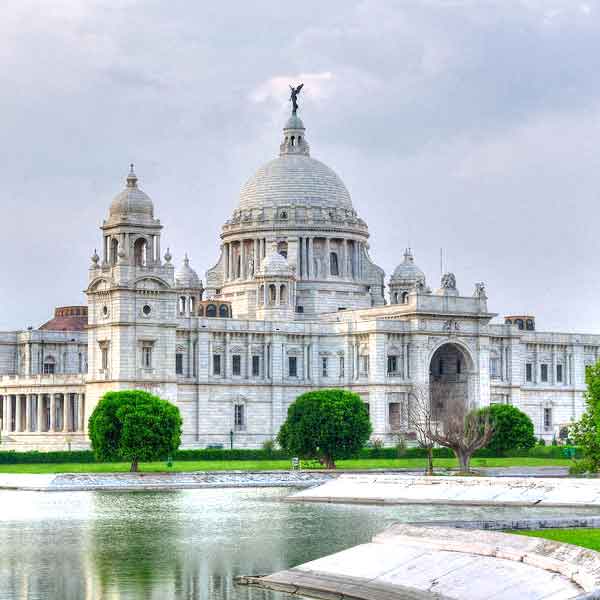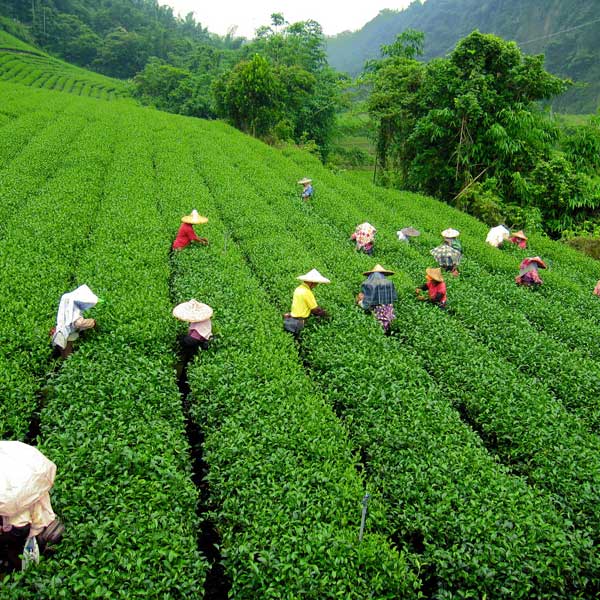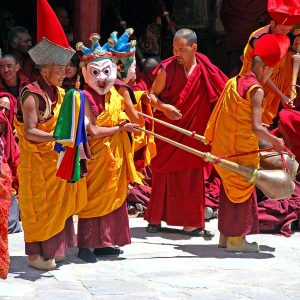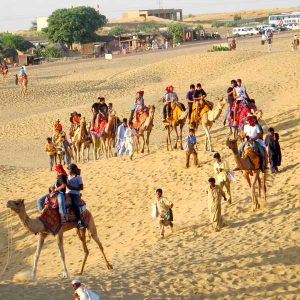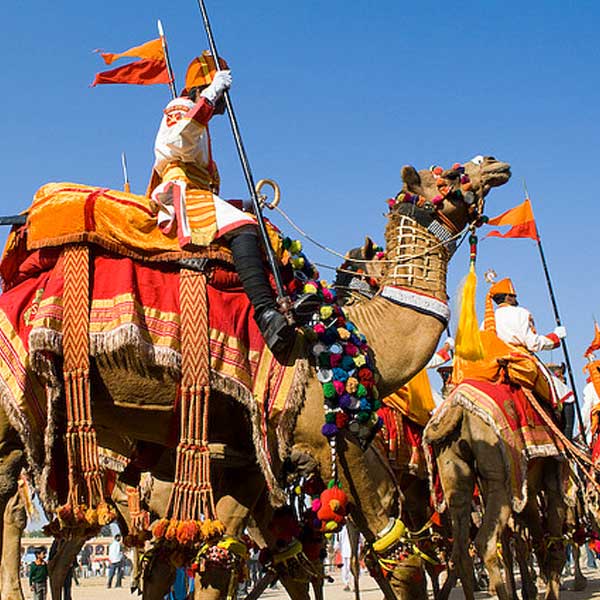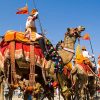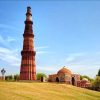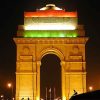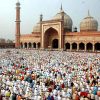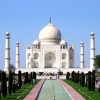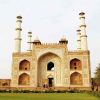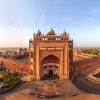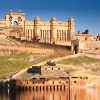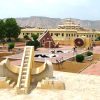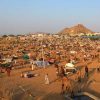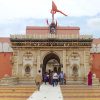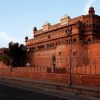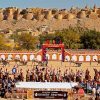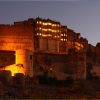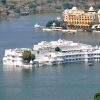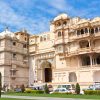Day 01 – Jan 31, 2014: Arrive Delhi.
You will be met upon arrival by our representative at the airport and transferred to your hotel. Afternoon at leisure to recover from jet lag. Overnight in Delhi.
In its 3000 years of existence; seven cities have risen where the present capital of India stands. Here you’ll encounter a fascinating blend of the ancient and the contemporary. Where government buildings, medieval palaces and bazaars exist beside a modern metropolis. Delhi is a city waiting to be explored. Overnight at the Hotel.
Day 02 – Feb 01, 2014: Delhi.
Delhi is India’s capital and its third largest city. It is a place of contrasts, from the stately, sweeping symmetry of the Raj Path to the crowded, bustling and narrow streets of Old Delhi. After breakfast, we take you on a comprehensive tour of both New and Old Delhi.
New Delhi is the eighth city to be built on this site and was laid out by the British in the early twentieth century to be an imperial capital from which to direct their affairs across the subcontinent. The city with its grandiose buildings and government institutions was readily inherited by India’s new leaders after Independence in 1947. We visit the India Gate memorial, New Delhi’s boldest emblem of its British builders, at the eastern, government end of the Rajpath. The ceremonial Rajpath avenue leads on to the vast sandstone presidential palace, larger even than Versailles. The whole Rajpath is ringed by well paved boulevards flanked by large houses and bungalows with blooming landscaped gardens.
The city of Old Delhi is next and we feel like we are stepping into a different world. Sights, sounds, heat and smells assail us. People and every kind of transport seemingly ever invented, crowd this old city. We take time to stroll through Chandni Chowk, Old Delhi’s ‘main’ street and a colourful, frantic shopping bazaar. Many bargains can be found here (for the brave and hard-hearted) and in the tiny winding alleys that lead off it.
We find haven when we visit and tour the huge seventeenth century Red Fort, encircled by a massive red sandstone wall, built by the Mughal Shah Jahan and completed in 1648. It contains many marble palaces and courtyards and wandering around you can imagine its ancient splendour. India’s largest mosque, the Jama Masjid, lies opposite the Red Fort with its tapering minarets and onion domes, again mainly constructed from red sandstone and white marble. The central courtyard alone can hold 20,000 devotees but the size of the building did not stop the builders heavily featuring beautiful Mughal inlay work. Overnight in Delhi.
Day 03 – Feb 02, 2014: Delhi to Agra.
After breakfast drive to Agra. On arrival in Agra, check in at the hotel. Overnight in Agra.
Agra stands on the right bank of the river Yamuna, was once the seat of the Mughal rulers, the zenith of art and an enshrined romance. Agra is a town famous for its beautiful medieval monuments. The passion of the Mughals for building endowed it with some of the most stunning creations to the art of building in the world.
Day 04 – Feb 03, 2014: Agra.
Today, we take a sightseeing tour of Agra. The city’s most famous monuments date from its time as the Mughal capital of India in the 16th and 17th centuries. We, of course, visit possibly the most famous and most beautiful building in the world, the Taj Mahal. The Taj was built between 1632 and 1643 on the bank of the Yamuna by twenty thousand artisans together with thousands of elephants, camels, bullocks and mules, which were used to haul the construction materials to the site and power the pulleys. The Mughal Emperor Shah Jahan (of Delhi’s Red Fort) built it as a memorial tomb to his favourite wife Mumtaz Mahal (‘the jewel of the palace’) who died during the birth of their fourteenth child.
There are nearly as many stories about the Taj as there are books written about it. Whichever of the stories you believe, the Taj Mahal is truly a magical and enchanting building and it is worth visiting several times during the day to view it as the changing light reflects differently off the marble.
We also visit the huge Agra Fort, similar to Delhi’s Red Fort but in many ways more impressive and better preserved. Built by the emperor Akbar between 1566 and 1573, the fort is surrounded by huge 15m high walls but many of the buildings inside were changed and rebuilt by Akbar’s descendants Jehangir and Shah Jahan in their own more elaborate taste. We will also see a display of Agra’s famous marble inlay work and visit Akbar’s huge, beautifully carved red sandstone tomb at Sikandra, six miles north of Agra. The tomb has been damaged over time but is still impressive. It is guarded by four massive gates and was completed by his son Jehangir with his own typical Mughal inlay work. Overnight in Agra.
Day 05 – Feb 04, 2014: Agra to Jaipur via Fatehpur Sikri.
After breakfast drive to Jaipur. En route we visit Fatehpur Sikri, a deserted but almost perfectly preserved city. This was the Mughal empires shortest living capital city, built by Akbar in 1565 but deserted in favour of a return to Agra by 1586, when the water supply ran out. Akbar brought the best architects, planners and artisans from all his empire to create his ‘modern’ new city and it’s almost perfect preservation, aided by the durable red sandstone and the Archaeological Survey of India, enables us to imagine the pomp and splendour of this extravagant and decadent era. The complex is filled with palaces, gardens, mosques, halls, harems (holding up to 800 women!), courtyards and lakes as well as stables for elephants, horses and camels. The city was sadly abandoned due to the water sources drying up.
Later continue your drive Jaipur. On arrival in Jaipur, check in at hotel.
Maharaja Jai Singh II built Jaipur in the 18th century. It is a planned city built with ancient Hindu rules as the colonial capital of a richly colorful state. The whole city was painted pink to welcome the visit of Prince Albert in 1853.
Day 06 – Feb 05, 2014: Jaipur.
After breakfast, half-day excursion trip takes us to Amber Palace. This hilltop fortress, 11km north of Jaipur, was built around 1592 by Akbar’s army commander, the Maharaja Man Singh, and was once the capital of the Minas people. It is a stunning example of Rajput architecture, inside and out, and looks down from its seat in the Aravalli Hills into its reflection in the lake below. You will likely see brightly painted elephants being washed down in the lake and have the option of an elephant ride up to the fort-palace complex. Inside the fort the Jai Mandir temple contains the world famous Sheesh Mahal, or hall of mirrors.
We visit the Jantar Mantar, his fascinatingly built, outdoor astronomical observatory in our morning city tour here. We also visit the ‘heart of the city’, the City Palace which is still used by the local Maharaja as a residence and for state festivals. Here we are shown small, ornate palaces and courtyards as well as museum piece Rajput weaponry classic Afgan and Pakistani carpets, miniature paintings (for which Jaipur is famous) and rare Sanskrit and Quranic manuscripts. On a grander scale one of India’s largest chandeliers is found here as well as supposedly the world’s two largest silver urns.
We complete our tour with the Hawa Mahal, or Palace of the Winds, a five storey, one room deep facade, delicately ornamented with gilded arches and overhanging balconies. Its 593 stone screens were built so that veiled royal women could view the scene below without being visible themselves.
We return to the hotel and rest of the day is ours to explore the city’s bazaars and try our hand at shopping Indian style. Jaipur is a shopper’s paradise and is famous for its precious and semi-precious stones (though you should know a little about gems before you buy here) and block painted cloth, as well as miniature paintings and ornaments like Jaipur’s own ‘blue’ pottery. Overnight at hotel in Jaipur.
Day 07 – Feb 06, 2014: Jaipur to Nagaur.
This morning, we proceeed to Nagaur. On arrival, transfer to tented camp on the periphery of the Nagaur Fair area.
The town of Nagaur has been the bastion of the Rajputs. Here you can hear the jingle of bells as camels or sheep wend their paths from village to village. And with them go the hardy people of these parts. The men with their proud moustaches and brightly colored turbans. And the women, in their gaily-printed skirts and heavy silver Jewellery. And centuries of tradition follow in their steps.
Nagaur Festival is also called as the Cattle Fair, is the 2nd largest animal fair of India. Thousands of animals are gathered at the cattle fair for trading. Traders come to buy and sell cows, bullocks, oxen and camels. Overnight in the Tent.
Day 08 – Feb 07, 2014: Nagaur Cattle Fair.
The Nagaur Festival is organized by the Department of Animal Husbandry in co-operation with the Department of Tourism, Government of Rajasthan. As per the latest statistical records, approximately 80,000 cattle owners participate in this festival with more than 200,000 cattles being traded. Enjoy the Nagaur festival. Overnight in Tented Camp in Nagaur.
Day 09 – Feb 08, 2014: Nagaur to Bikaner.
This morning, after a leisurely breakfast we’ll proceed on a 2 hrs drive to Bikaner. The countryside becomes progressively drier overnight as we entered the Thar Desert, although the Ganga canal provides irrigation and greenery for a large area around Bikaner itself. This canal was named after, and built by, one of Bikaner’s most influential rulers, the Maharaja Ganga Singh (1880 – 1943). He was responsible for the construction of many of Bikaner’s finest buildings and the canal transformed his poor, drought ridden countryside into India’s largest granary. He also formed the famous Camel Corps, the Indian military’s most prestigious unit.
We arrive in Bikaner in the afternoon and transfer straight to our hotel. The afternoon is free for you to explore the narrow winding streets of the old walled city which throng with tiny stalls and shops selling everything from fruit and vegetables to jewellery, pots and pans, and camel hide ornaments. They also hide temples and some old havellis (sandstone and wood houses featuring ornate carving). The streets are a riot of colour with the local women’s dazzling red, green and yellow saris, together with the local desert nomads wearing their clan coloured turbans. Overnight in Bikaner.
Day 10 – Feb 09, 2014: Bikaner.
This morning we visit some of Bikaner’s best sites. The Junagarh Fort is one of Rajasthan’s most impressive with huge walls, bastions and a moat, all of which helped it gain its position as one of the few forts in India never to be overthrown. Everything is built from red sandstone and marble, much of it beautifully carved. There are a plethora of palaces, courtyards, halls and towers inside the walls, some lined with ornate mirrors, stained glass, paintings and mosaics. There is also an interesting museum.
We can make an afternoon trip out to the village of Deshnok, about 30km south of Bikaner, to see the incredible Karni Mata Temple, which swarms with hundreds of holy rats. Letting these rats run over your bare feet, or even sharing the grain and sweetmeats that they have nibbled, is considered most auspicious. Overnight in Bikaner.
Day 11 – Feb 10, 2014: Bikaner to Jaisalmer.
We’ll depart after an early breakfast for Jaisalmer, one of the most idyllic and unspoiled areas in western India. The eight hour drive through the Rajasthani countryside is punctuated by colorful villagers on their way to the local well, troops of camels, congregations of free-roaming peacocks, and an occasional roadside shrine. Arrive in Jaisalmer in the late afternoon and check into a Hotel, overlooking the fort.
This evening visit Bada Bagh, to view the royal cenotaphs with their beautifully carved ceilings and equestrian statues of former rulers. Watch the sun go down, turning the sandstone ramparts of this incomparably romantic city a deep golden color. Return to the hotel after dusk with time at leisure. Overnight in Jaisalmer.
Day 12 – Feb 11, 2014: Jaisalmer.
In the morning explore Jaisalmer Fort, built in 1156 by the Rajput Prince Rawal Jaisal. A large part of the old city’s population still resides in the fort, with little change over the centuries. Enter the narrow winding lanes vivid with the colors of the desert and fragrant with heaps of flowers and fruit. Inside there are spectacular havelis, 19th-century mansions built by wealthy merchants, richly painted and elaborately carved in golden sandstone. Balconies, colonnades, and pavilions rise like giant surreal flowers from courtyards below. Also see the Jain temples with dozens of small filigree towers that enclose lushly carved interiors with leaves, birds, and animals covering every surface.
In the late afternoon, leave the city for a brief camel ride over the sand dunes at sunset. Return to Jaisalmer for dinner at the hotel. Overnight in Jaisalmer.
Day 13 – Feb 12, 2014: Jaisalmer Desert Festival.
Today we have a wonderful opportunity to experience the exciting spectacle of the golden city’s grand parade. As the drums of Rajasthan beat out aloud brightly adorned elephants with their mahouts and tassel laden camels and riders, colourful floats, singers, dancers and marching bands will waltz on by in the city’s annual street parade.
We too will enter the stadium (scheduled to arrive at 12 noon) and watch the festival events for an hour or so before continuing with our city sightseeing tour (time permitting). It is worth finding out where the longest moustache and turban tying competitions are being held – a fascinating and enjoyable part of the festive activities. Later in the afternoon after time to freshen up and have some lunch we enjoy a camel ride across the vast, rolling sand dunes of the desert. Overnight in Jaisalmer.
Day 14 – Feb 13, 2014: Jaisalmer to Jodhpur.
Today we take an interesting drive through increasingly varied scenery takes us to Jodhpur, a town at the edge of the mighty Thar Desert. Again we end our journey with the sight of a city rising out of the sand. This is Jodhpur, with its massive medieval cliff top fort, and famous blue painted old city 125m below. Jodhpur, centre of the principality of Marwar (or ‘Land of death’), like Jaisalmer, was also on the main caravan routes. Its rulers reaped similar benefits, becoming fantastically wealthy, and themselves had to defend against numerous attacks.
On arrival, we’ll be transferred to our hotel. Overnight in Jodhpur.
Day 15 – Feb 14, 2014: Jodhpur.
We take a brief morning tour of Jodhpur’s Mehrangarh (Majestic) fort, admiring the security provided by the 120m cliffs and seven gates on the 5km winding road which leads up to the top. The fort contains the usual ornate maze of palaces and courtyards, but here the palaces house an incredible assortment of the trappings of Indian royal living. The maharaja’s bedroom is the highlight, with love swings, a huge bed, mosaics and mirrored walls. Other antiquities range from Rajput weaponry and armour to royal rocking cradles. Out in the fresh air we get a breathtaking sight of the old city from the ramparts at the southern end of the fort.
The sounds of the bustle of life below float up to us and we get the best view of the blue painted houses. This blue colour originally signified the home of a Brahmin but is now used extensively and is believed to repel mosquitoes. The afternoon is free for us to explore the clamour of the old city. A good place to start is the clock tower. The many different specialised bazaars surrounding Sadar market are not far from here and make for a fascinating aimless stroll. Overnight in Jodhpur.
Day 16 – Feb 15, 2014: Jodhpur to Udaipur.
This morning, after breakfast we’ll drive to Udaipur. On arrival we’ll settle down in our hotel.
The city of Udaipur, named after its Mewar founder Maharana Udai Sing II in1568, makes a delightful contrast to the fortress-like cities that we have seen so far. Nestled in a valley surrounded by hills this delightful city of lakes, island palaces and hilltop forts is surely one of India’s most romantic. The two main lakes, Pichola and Fateh Sagar are lined with gardens, ghats, guest houses and palaces. The several islands within the lakes contain even more impressive white, fairy-tile like palaces (including ‘Lake Palace’, the one made famous in the West by the James Bond ‘Octopussy’ movie). Overnight in Udaipur.
Day 17 – Feb 16, 2014: Udaipur.
We take you on a tour this morning of the City Palace and its museum. This is the largest of Rajasthan’s city palace complexes and dominates the old city around and below it. Udai Singh’s original stronghold forms the centre of the palace but remarkably, the Rajput grandeur of all the additions of successive generations fits together harmoniously. Between the two main entrance gates are eight arches under which former rulers were weighed. This weight in gold and silver was then distributed to the poor of the city. The museum contains some incredibly ornate mosaic and mirror walled rooms and a quality display of miniature paintings. Fine views of the lake can be got from the rooftop gardens and overhanging terraces.
The afternoon is yours again to explore this charming city and to relax. You may want to visit the glorious Lake Palace, now run by the Taj Group as a super luxury hotel. The Old city itself is a pleasure to stroll around with many good jewellery shops and many more selling a whole quality range of miniature paintings. The skill of these, often very young, painters can be seen at work in many of these shops though you should be prepared to bargain when shopping. Overnight at hotel in Udaipur.
Day 18 – Feb 17, 2014: Udaipur to Delhi. Depart Delhi.
This morning w are transferred to the airport to board our flight back to Delhi. Later, in time assistance to board your flight to onward destination.
Date and price to suit individual arrangements based on 2 people sharing. Breakfast included. Private air-conditioned car and driver with English speaking guides for sightseeing.

